Piston Compression Ring Elastodynamics and Ring–Liner Elastohydrodynamic Lubrication Correlation Analysis
Abstract
1. Introduction
2. Theories of Ring Elastodynamics
2.1. In Situ Ring Elastodynamics
2.2. Out-of-Plane Dynamics of the Piston Compression Ring
2.3. Film profile of Piston Compression Ring and cylinder liner conjuction
2.4. Lubricant Rheology of Elastodynamic Ring and Liner Conjunction
2.5. Viscosity–Temperature–Pressure Interrelation
2.6. Density–Temperature–Pressure Interrelation
2.7. Theory of Ring Elastohydrodynamics
2.8. Assumption of the Combined Elastodynamic and Elastohydrodynamic Analysis
2.9. Validation of the Model
2.10. Solution Steps with Flow Chart for Computation
3. Results and Discussion
3.1. Elastodynaimcs and Elastodynamics Correlation Analysis
3.2. Finite Element Analysis of Elastic Ring Subjected to Elastodynamics
4. Conclusions
- The maximum increase in film thickness was observed to be 51.8% in the suction stroke, while it was 47% in the compression stroke, 50% in the power stroke and 52% in the exhaust stroke;
- The asperity contact force is reduced by 10% and 23.53% due to elastodynamic considerations at top and bottom dead center, respectively;
- The elastic ring shows reduced asperity friction loss compared to rigid ring at the crank location of 360° (at TDC);
- The highest viscous friction is reduced by 23.53% due to consideration of ring elastodynamics at 373° crank location;
- More friction power loss in the suction stroke compared to other strokes was observed, with a maximum increase of 72%;
- Frictional power loss remarkably decreases at 1500 rpm in the power stroke due to consideration of elastodynamics;
- When the speed of rotation increases, the lubricant oil flow to the conjunction increases for both the rigid and elastic rings;
- At 1500 rpm, both film thickness and oil flow decrease due to consideration of elastodynamics;
- Oil flow increases by a maximum of up to 26% during the compression stroke at 1000 rpm, while its lowest is 7.7% in the power stroke at 1500 rpm.
Author Contributions
Funding
Data Availability Statement
Conflicts of Interest
List of Symbols
| Cross sectional area of the ring | mm2 | |
| Asperity contact area | mm2 | |
| Coefficient used to calculate asperity contact pressure | ||
| Bore nominal diameter | mm | |
| Elastic modulus of the ring material | GPa | |
| Tangential shear force | N | |
| Greenwood and Trip statistical function | ||
| Force acting on the boundary interaction | N | |
| Force component due to viscous action | N | |
| Net in-plane force | N | |
| Net out-of-plane force | N | |
| Ring elastic force | N | |
| Applied gas pressure force | N | |
| Distance between oil ring bottom land and piston pin center | mm | |
| Distance between oil ring bottom land and piston CG | mm | |
| Distance between pin center and piston CG | mm | |
| Minimum gap between out-of-round bore and conformed ring | mm | |
| Total film thickness | µm | |
| Nominal film thickness | µm | |
| Film thickness in sliding direction | µm | |
| Film thickness in side-leak direction | µm | |
| Moment of inertia of the ring | mm4 | |
| Mass of the ring per unit length | gm | |
| Pressure | N/mm2 | |
| Atmospheric pressure | N/mm2 | |
| General force function | ||
| Ring nominal crown radius | mm | |
| Ring shape function | µm | |
| Time | s | |
| Lubricant reaction | N | |
| Asperity contact load | N | |
| Greek Symbols | ||
| Coefficient for asperity contact calculation | ||
| Piezo-viscous coefficient | Pa−1 | |
| Thermo-viscous coefficient | ||
| Oil dependent fitting parameters | ||
| Shear dependent viscosity | Pa.s | |
| Low shear rate viscosity | Pa.s | |
| High shear rate viscosity | Pa.s | |
| Shear rate | s−1 | |
| Temperature of the lubricant | °K | |
| Initial temperature of the lubricant | °K | |
| Viscosity or reference viscosity | Pa.s | |
| Shear rate or reference shear rate | N/mm2 | |
| Reference density or density | kg/m3 | |
| Pressure coefficient of boundary friction | ||
| Ring circumferential location | degree | |
| Ring global deformation | µm | |
| Ring local deformation | µm | |
| Parameter to calculate asperity contact pressure | ||
| Parameter to calculate asperity contact pressure |
References
- Lamb, H. On the Flexure and the Vibrations of a Curved Bar. Proc. Lond. Math. Soc. 1887, 1, 365–377. [Google Scholar] [CrossRef]
- Den Hartog, J.P. The Lowest Natural Frequency of Circular Arcs, London, Edinburgh Dublin Philos. Mag. J. Sci. 1928, 5, 400–408. [Google Scholar] [CrossRef]
- Brown, F.H. Lateral vibration of ring-shaped frames. J. Frankl. Inst. 1934, 218, 41–48. [Google Scholar] [CrossRef]
- Archer, R.R. Small vibrations of thin incomplete circular rings. Int. J. Mech. Sci. 1960, 1, 45–56. [Google Scholar] [CrossRef]
- Love, A.E.H. A Treatise on Mathematical Theory of Elasticity; Dover Publications: New York, NY, USA.
- Volterra, E.; Morell, J.D. Lowest Natural Frequency of Elastic Arc for Vibrations Outside the Plane of Initial Curvature. ASME J. Appl. Mech. 1961, 28, 624–627. [Google Scholar] [CrossRef]
- Rao, S. Effects of transverse shear and rotatory inertia on the coupled twist-bending vibrations of circular rings. J. Sound Vib. 1971, 16, 551–566. [Google Scholar] [CrossRef]
- Endo, M. Flexural Vibrations of a Ring with Arbitrary Cross Section. Bull. JSME 1972, 15, 446–454. [Google Scholar] [CrossRef]
- Hawkings, D. A generalized analysis of the vibration of circular rings. J. Sound Vib. 1977, 54, 67–74. [Google Scholar] [CrossRef]
- Dowson, D.; Ruddy, B.L.; Economou, P.N. The elastohydrodynamic lubrication of piston rings. Proc. R. Soc. London. Ser. A Math. Phys. Sci. 1983, 386, 409–430. [Google Scholar] [CrossRef]
- Furuhama, S.; Sasaki, S. New Device for the Measurement of Piston Frictional Forces in Small Engines; SAE Paper No. 831284; SAE: Warrendale, PA, USA, 1983. [Google Scholar]
- Tian, T.; Noordzij, L.B.; Wong, V.W.; Heywood, J.B. Modeling Piston-Ring Dynamics, Blowby, and Ring-Twist Effects. J. Eng. Gas Turbines Power 1998, 120, 843–854. [Google Scholar] [CrossRef]
- Tian, T.; Wong, V.W.; Heywood, J.B. A Piston Ring-Pack Film Thickness and Friction Model for Multigrade Oils and Rough Surfaces; SAE Paper 962032; SAE: Warrendale, PA, USA, 1996. [Google Scholar]
- Tian, T. Dynamic behaviours of piston rings and their practical impact. Part 2: Oil transport, friction and wear of ring/liner interface and the effects of piston and ring dynamics. Proc. Inst. Mech. Eng. Part J J. Eng. Tribol. 2002, 216, 229–248. [Google Scholar] [CrossRef]
- Ejakov, M.A.; Schock, H.J.; Brombolich, L.J. Modeling of Ring Twist For an IC Engine; SAE Technical Paper Series; SAE: Warrendale, PA, USA, 1998. [Google Scholar] [CrossRef]
- Liu, K.; Xie, Y.B.; Gui, C.L. A comprehensive study of the friction and dynamic motion of the piston assembly. Proc. Inst. Mech. Eng. Part J J. Eng. Tribol. 1998, 212, 221–226. [Google Scholar] [CrossRef]
- Rahmani, R.; Theodossiades, S.; Rahnejat, H.; Fitzsimons, B. Transient elastohydrodynamic lubrication of rough new or worn piston compression ring conjunction with an out-of-round cylinder bore. Proc. Inst. Mech. Eng. Part J J. Eng. Tribol. 2012, 226, 284–305. [Google Scholar] [CrossRef]
- Baker, C.; Rahmani, R.; Karagiannis, I.; Theodossiades, S.; Rahnejat, H.; Frendt, A. Effect of Com-Pression Ring Elastodynamics Behaviour upon Blowby and Power Loss; SAE Technical Paper Series; SAE: Warrendale, PA, USA, 2014. [Google Scholar] [CrossRef]
- Dlugoš, J.; Novotný, P. Computational Modelling of Piston Ring Dynamics in 3D. J. Middle Eur. Constr. Des. Cars 2014, 12, 1–7. [Google Scholar] [CrossRef]
- Baker, C.; Rahmani, R.; Theodossiades, S.; Rahnejat, H.; Fitzsimons, B. On the Effect of Transient In-Plane Dynamics of the Compression Ring Upon Its Tribological Performance. J. Eng. Gas Turbines Power 2014, 137, 032512. [Google Scholar] [CrossRef]
- Liu, Y.; Tian, T. Development and Application of Ring-Pack Model Integrating Global and Local Processes. Part 1: Gas Pressure and Dynamic Behavior of Piston Ring Pack. SAE Int. J. Engines 2017, 10, 1927–1939. [Google Scholar] [CrossRef]
- Liu, Y.; Li, Y.; Tian, T. Development and Application of Ring-Pack Model Integrating Global and Local Processes. Part 2: Ring-Liner Lubrication. SAE Int. J. Engines 2017, 10, 1969–1983. [Google Scholar] [CrossRef]
- Baker, C.; Theodossiades, S.; Rahmani, R.; Rahnejat, H.; Fitzsimons, B. On the Transient Three-Dimensional Tribodynamics of Internal Combustion Engine Top Compression Ring. J. Eng. Gas Turbines Power 2017, 139, 062801. [Google Scholar] [CrossRef]
- Turnbull, R.; Mohammadpour, M.; Rahmani, R.; Rahnejat, H.; Offner, G. Coupled elastodynamics of piston compression ring subject to sweep excitation. Proc. Inst. Mech. Eng. Part K J. Multi-body Dyn. 2017, 231, 469–479. [Google Scholar] [CrossRef]
- Morris, N.; Mohammadpour, M.; Rahmani, R.; Johns-Rahnejat, P.M.; Rahnejat, H.; Dowson, D. Effect of cylinder deactivation on tribological performance of piston compression ring and connecting rod bearing. Tribol. Int. 2018, 120, 243–254. [Google Scholar] [CrossRef]
- Mishra, P.C.; Balakrishnan, S.; Rahnejat, H. Tribology of compression ring-to-cylinder contact at reversal. Proc. Inst. Mech. Eng. Part J J. Eng. Tribol. 2008, 222, 815–826. [Google Scholar] [CrossRef]
- Lang, T.E. Vibration of Thin Circular Rings, Part 1; Technical Report No. 32-261; Jet Propulsion Laboratory, California Institute of Technology: Pasadena, CA, USA, 1962. [Google Scholar]
- Problems of Reducing Friction Losses of a Piston-Ring-Cylinder Configuration in a Combustion Piston Engine with an Increased Isochoric Pressure Gain; SAE Technical paper-2020-01-2227; SAE: Warrendale, PA, USA, 2020. [CrossRef]
- Zbigniew, S. A new generation of F1 race engines—Hybrid power units. Combust. Engines 2016, 167, 22–37. [Google Scholar] [CrossRef]
- Dziubak, T.; Dziubak, S.D. A Study on the Effect of Inlet Air Pollution on the Engine Component Wear and Operation. Energies 2022, 15, 1182. [Google Scholar] [CrossRef]
- Dziubak, T.; Karczewski, M. Experimental Studies of the Effect of Air Filter Pressure Drop on the Composition and Emission Changes of a Compression Ignition Internal Combustion Engine. Energies 2022, 15, 4815. [Google Scholar] [CrossRef]
- Alfadhli, A.; Alazemi, A.; Khorshid, E. Numerical minimisation of abrasive-dust wear in internal combustion engines. Int. J. Surf. Sci. Eng. 2020, 14, 68. [Google Scholar] [CrossRef]
- Davim, J.P. Tribology for Engineers: A Practical Guide; Elsevier: Amsterdam, The Netherlands, 2011; ISBN 9780081014912. [Google Scholar]
- Davim, J.P. Progress in Green Tribology; DE Gruyter: Berlin, Germany, 2017; ISBN 9783110372724. [Google Scholar]
- Davim, J.P. Mechanical and Industrial Engineering; Springer: Berlin/Heidelberg, Germany, 2022; ISBN 978-3-030-90486-9. [Google Scholar]
- Davim, J.P. Modern Mechanical Engineering; Springer: Berlin/Heidelberg, Germany, 2014; ISBN 978-3-642-45175-. [Google Scholar]
- Mishra, P.C.; Rahnejat, H.; King, P.D. Tribology of the ring—bore conjunction subject to a mixed regime of lubrication. Proc. Inst. Mech. Eng. Part C J. Mech. Eng. Sci. 2008, 223, 987–998. [Google Scholar] [CrossRef]
- Yang, P.; Cui, J.; Jin, Z.M.; Dowson, D. Transient Elastohydrodynamic Analysis of Elliptical Contacts. Part 2: Thermal and Newtonian Lubricant Solution. J. Eng. Tribol. 2005, 219, 187–200. [Google Scholar] [CrossRef]
- Gohar, R.; Rahnejat, H. Fundamentals of Tribology; Imperial College Press: London, UK, 2008. [Google Scholar]
- Chong, W.; Howell-Smith, S.; Teodorescu, M.; Vaughan, N. The influence of inter-ring pressures on piston-ring/liner tribological conjunction. Proc. Inst. Mech. Eng. Part J J. Eng. Tribol. 2012, 227, 154–167. [Google Scholar] [CrossRef]
- Greenwood, J.A.; Tripp, J.H. The Contact of Two Nominally Flat Rough Surfaces. Proc. Inst. Mech. Eng. 1970, 185, 625–633. [Google Scholar] [CrossRef]
- Wróblewski, P.; Rogólski, R. Experimental Analysis of the Influence of the Application of TiN, TiAlN, CrN and DLC1 Coatings on the Friction Losses in an Aviation Internal Combustion Engine Intended for the Propulsion of Ultralight Aircraft. Materials 2021, 14, 6839. [Google Scholar] [CrossRef]
- Styles, G.; Rahmani, R.; Rahnejat, H.; Fitzsimons, B. In-cycle and life-time friction transience in piston ring–liner conjunction under mixed regime of lubrication. Int. J. Engine Res. 2014, 15, 862–876. [Google Scholar] [CrossRef]

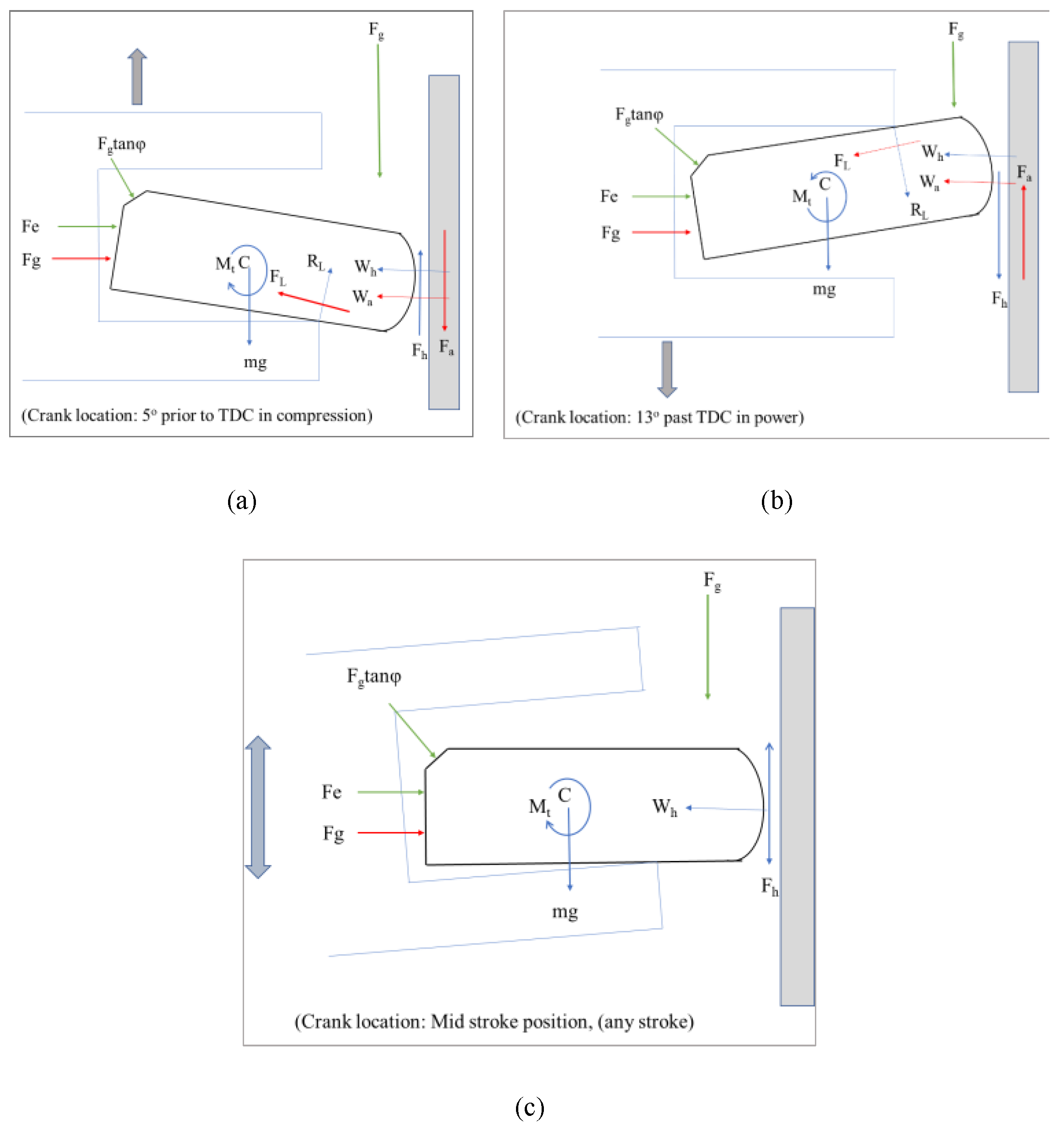
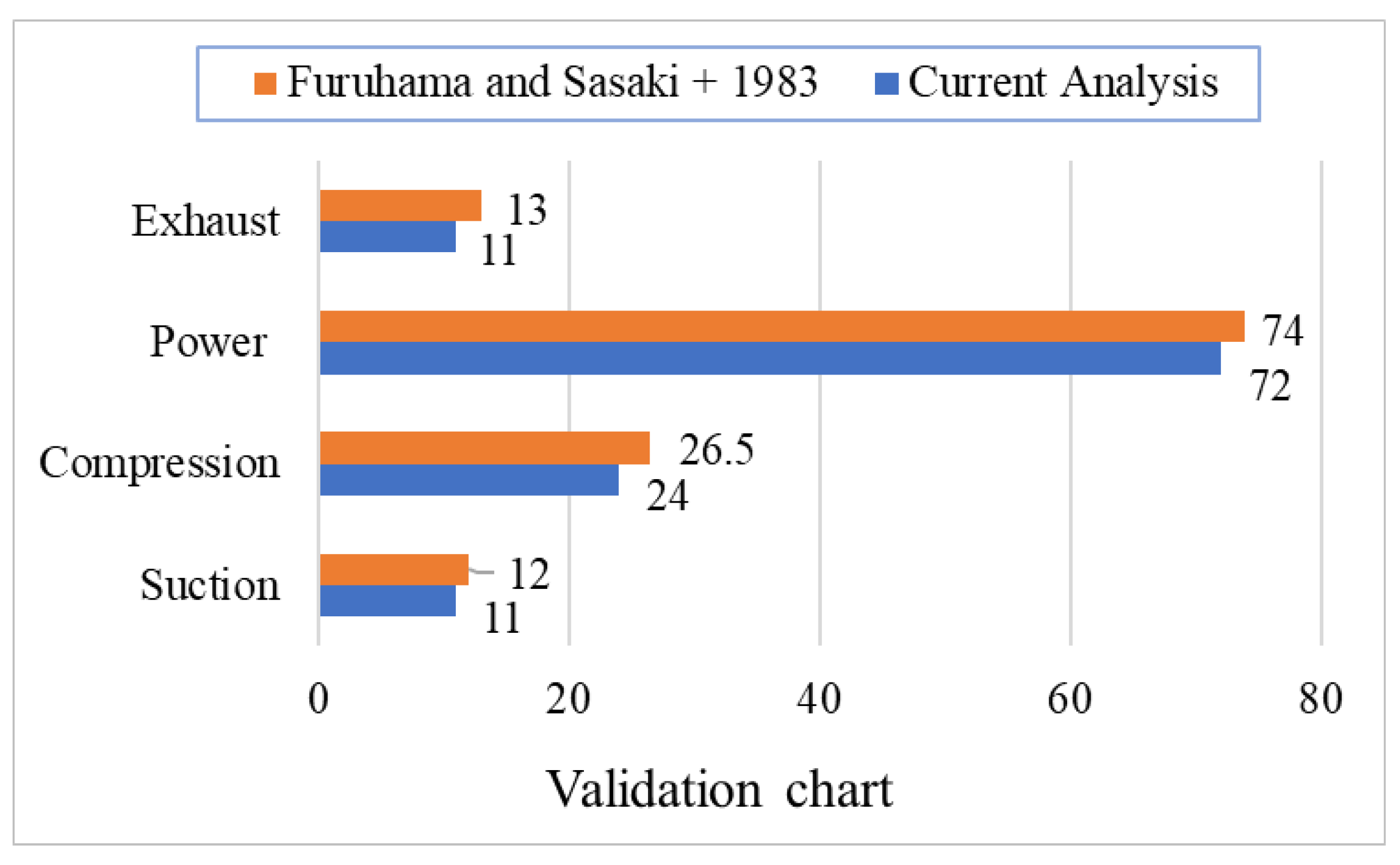
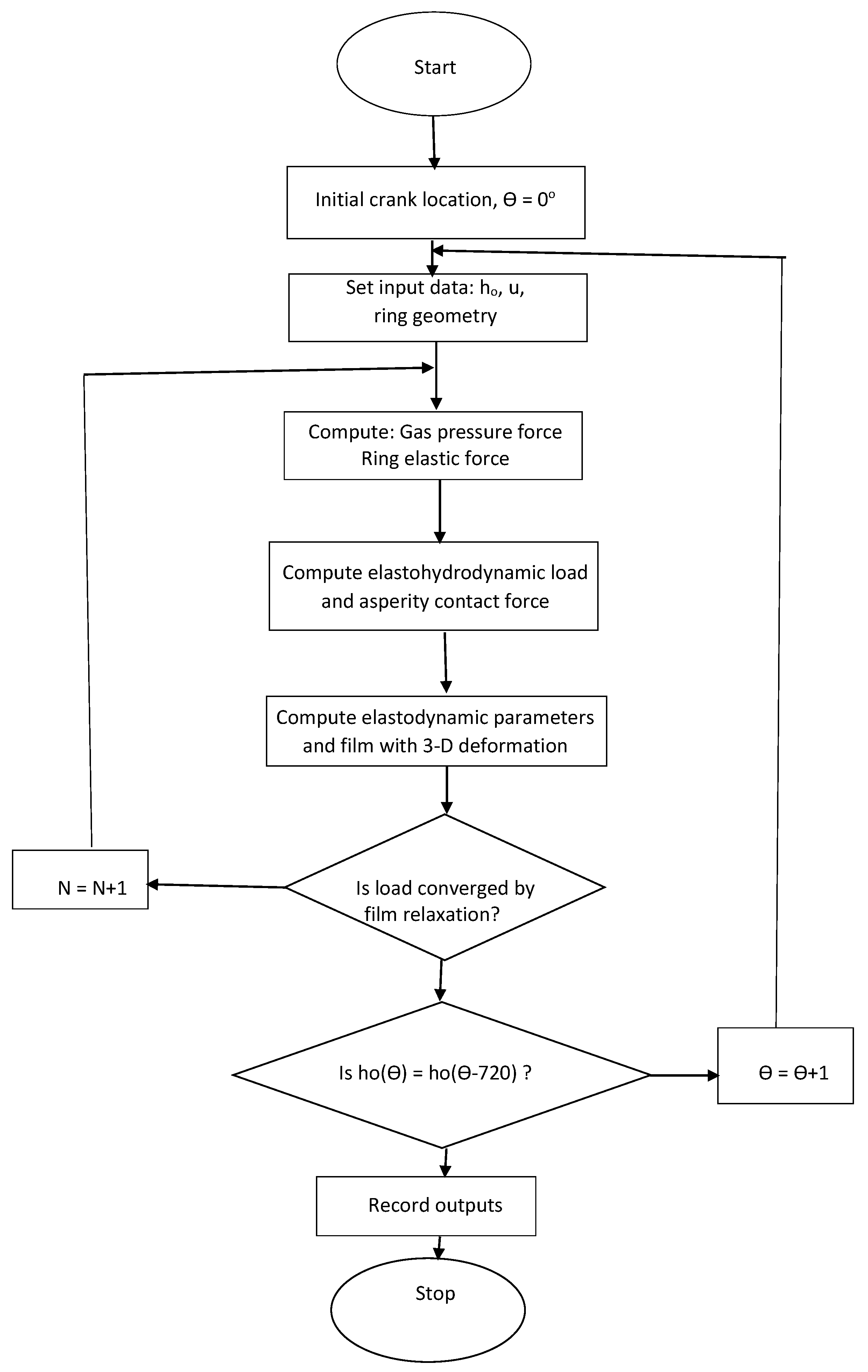
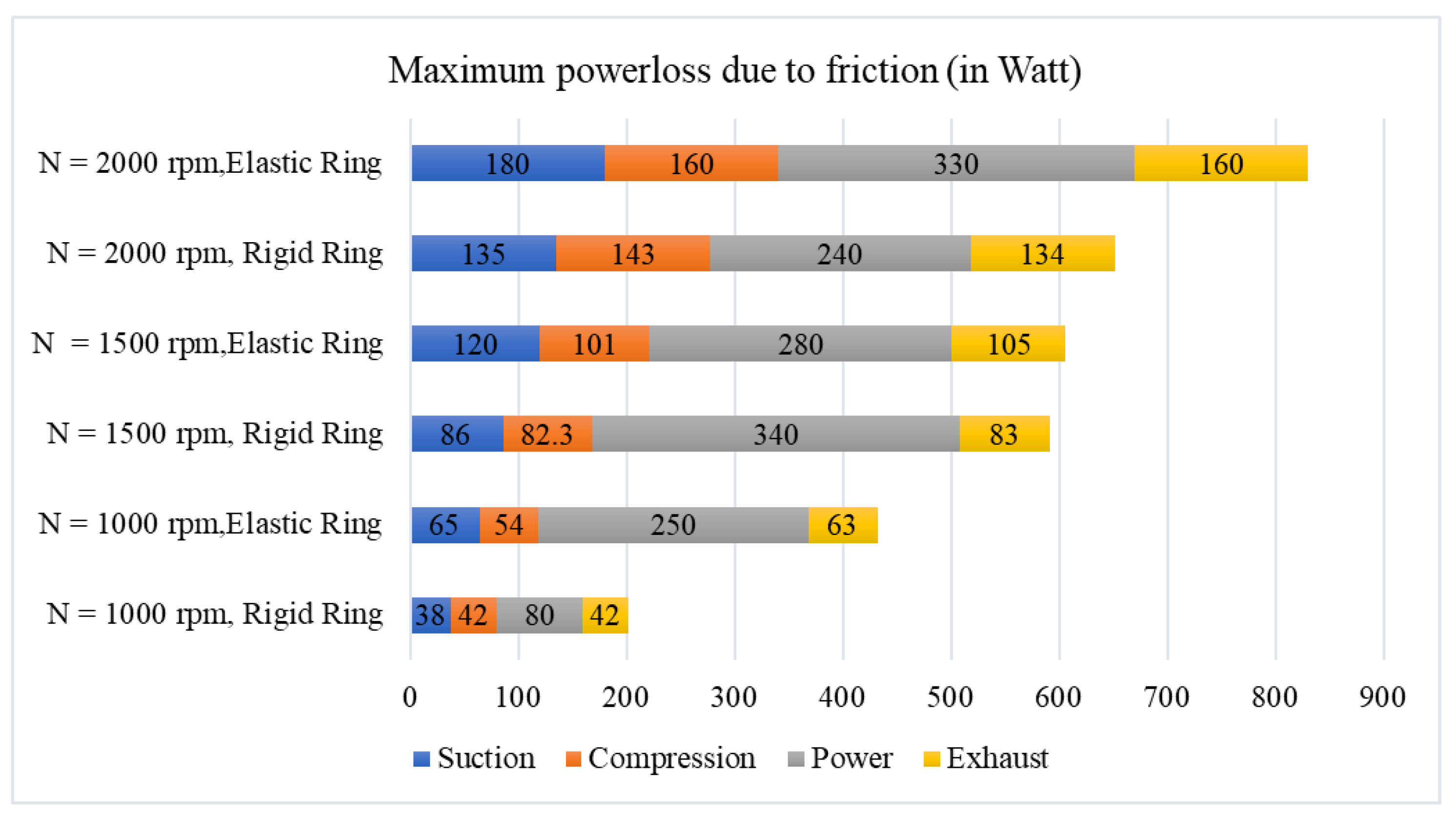
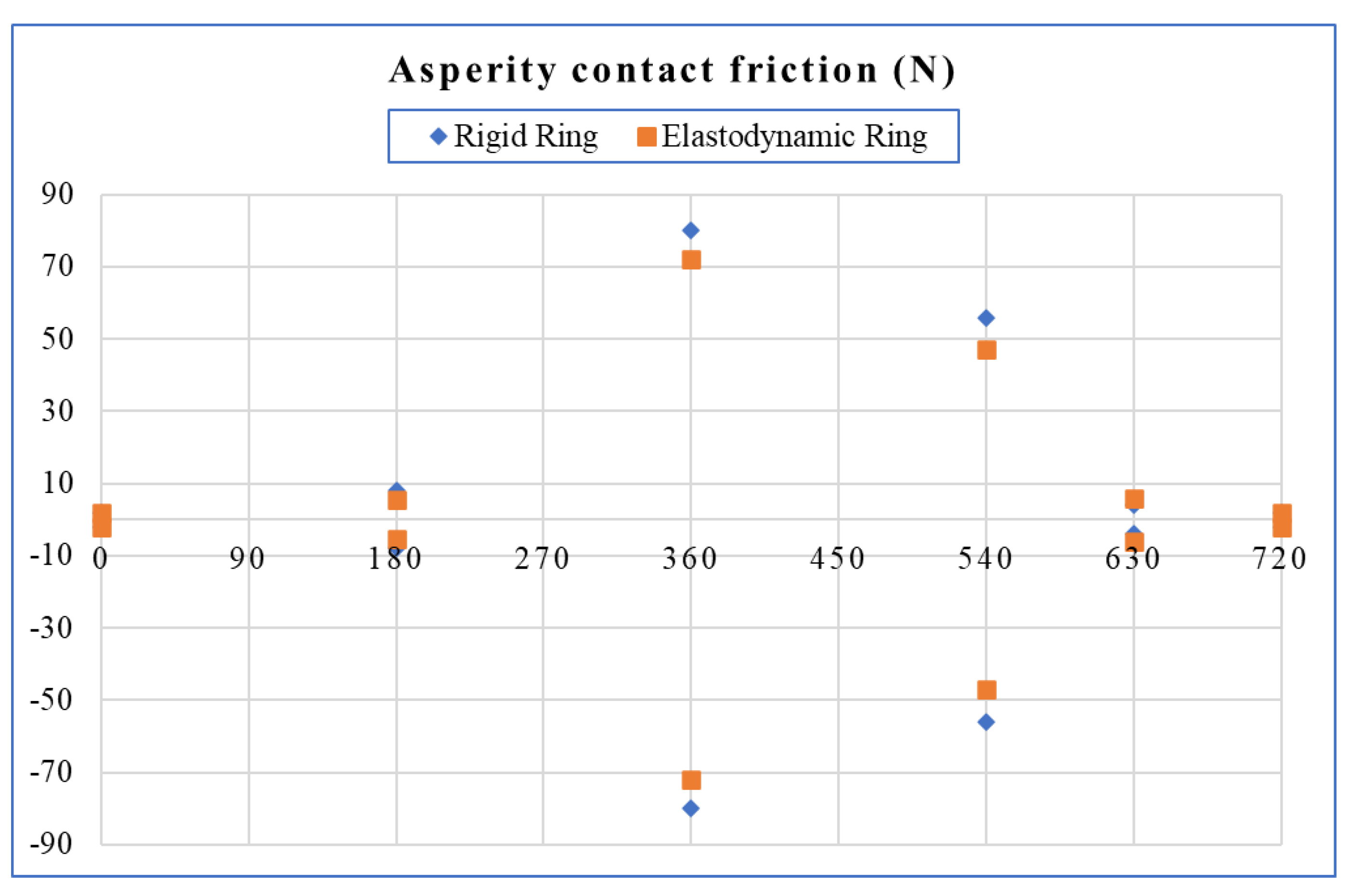
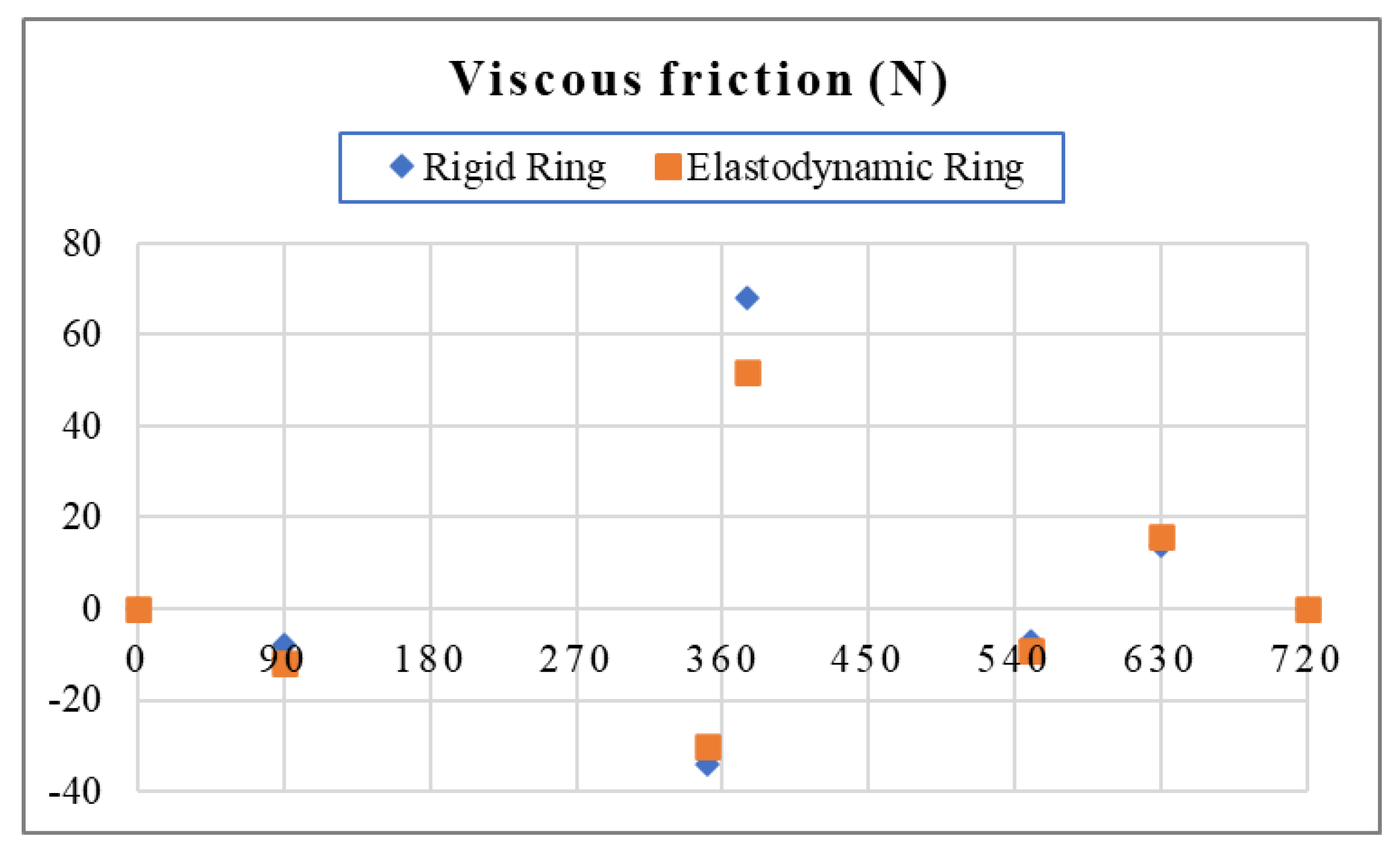

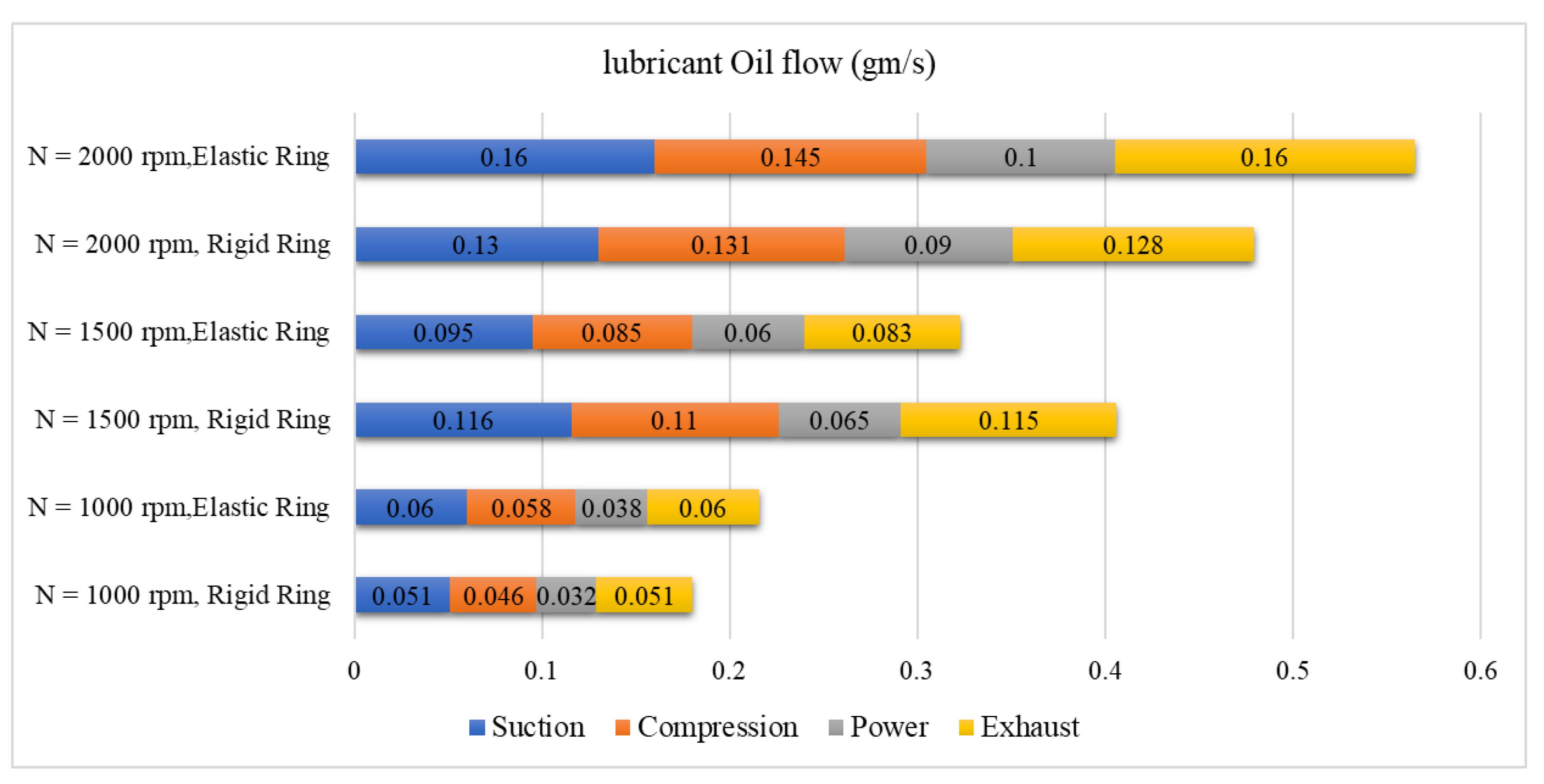
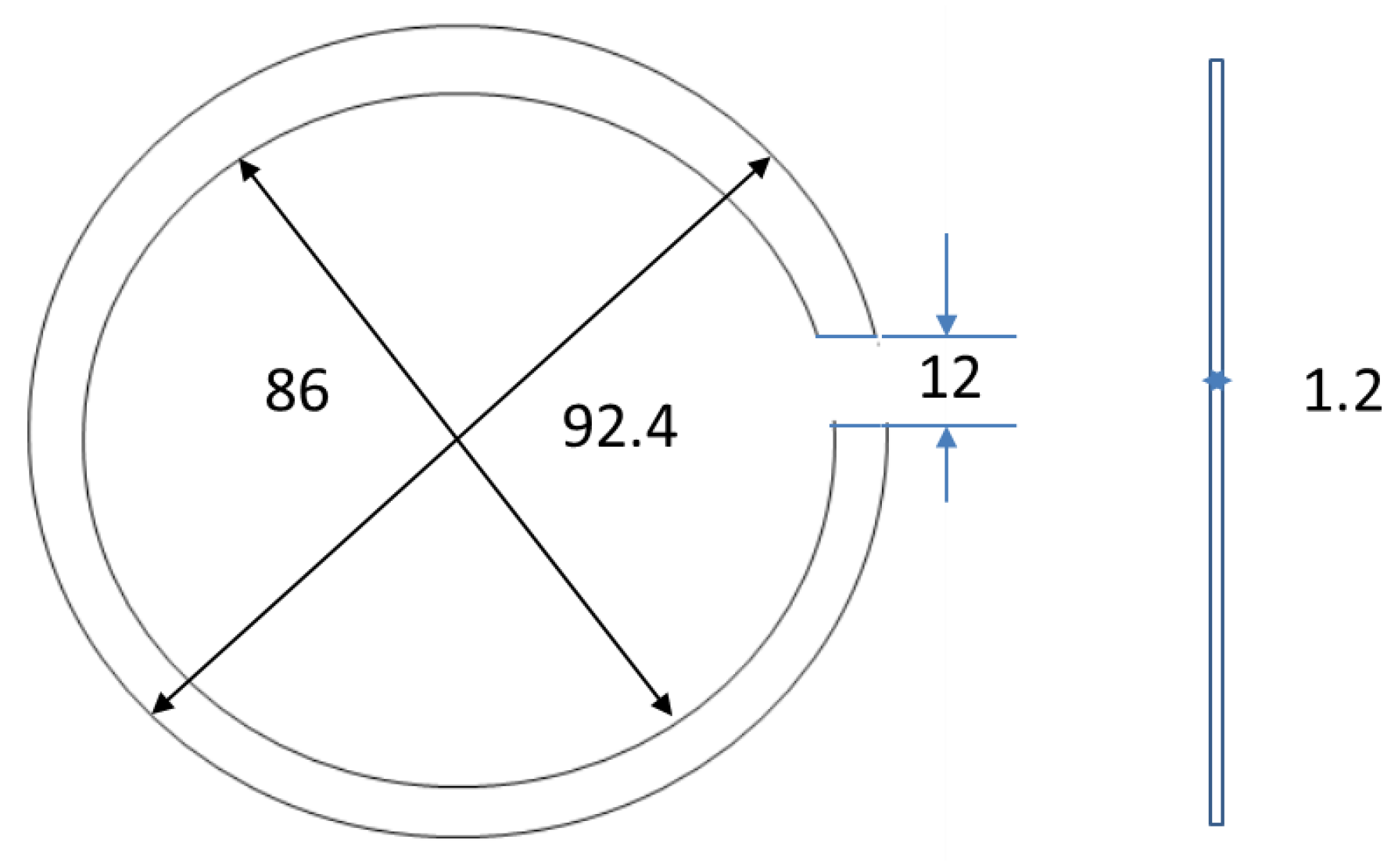
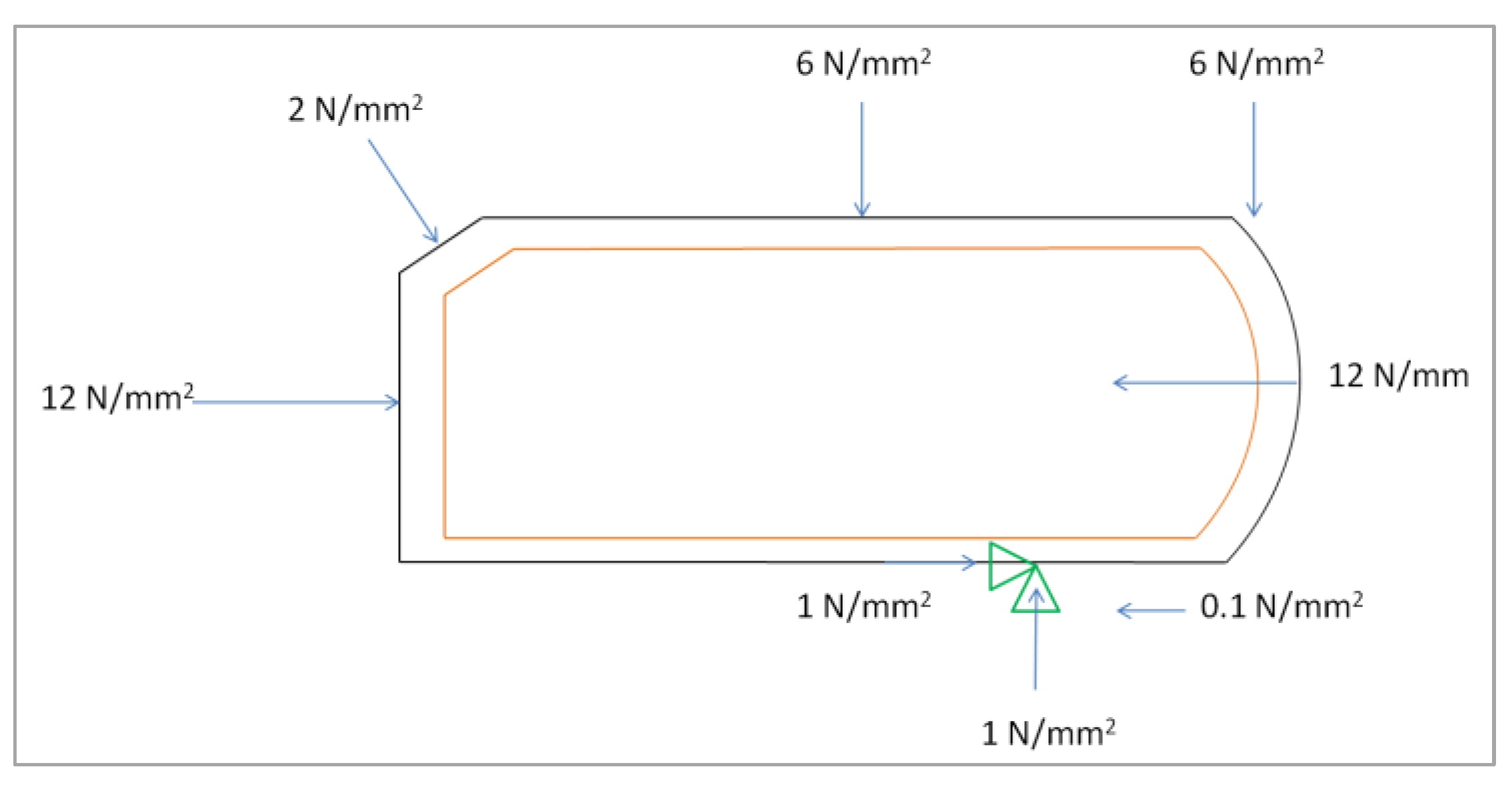
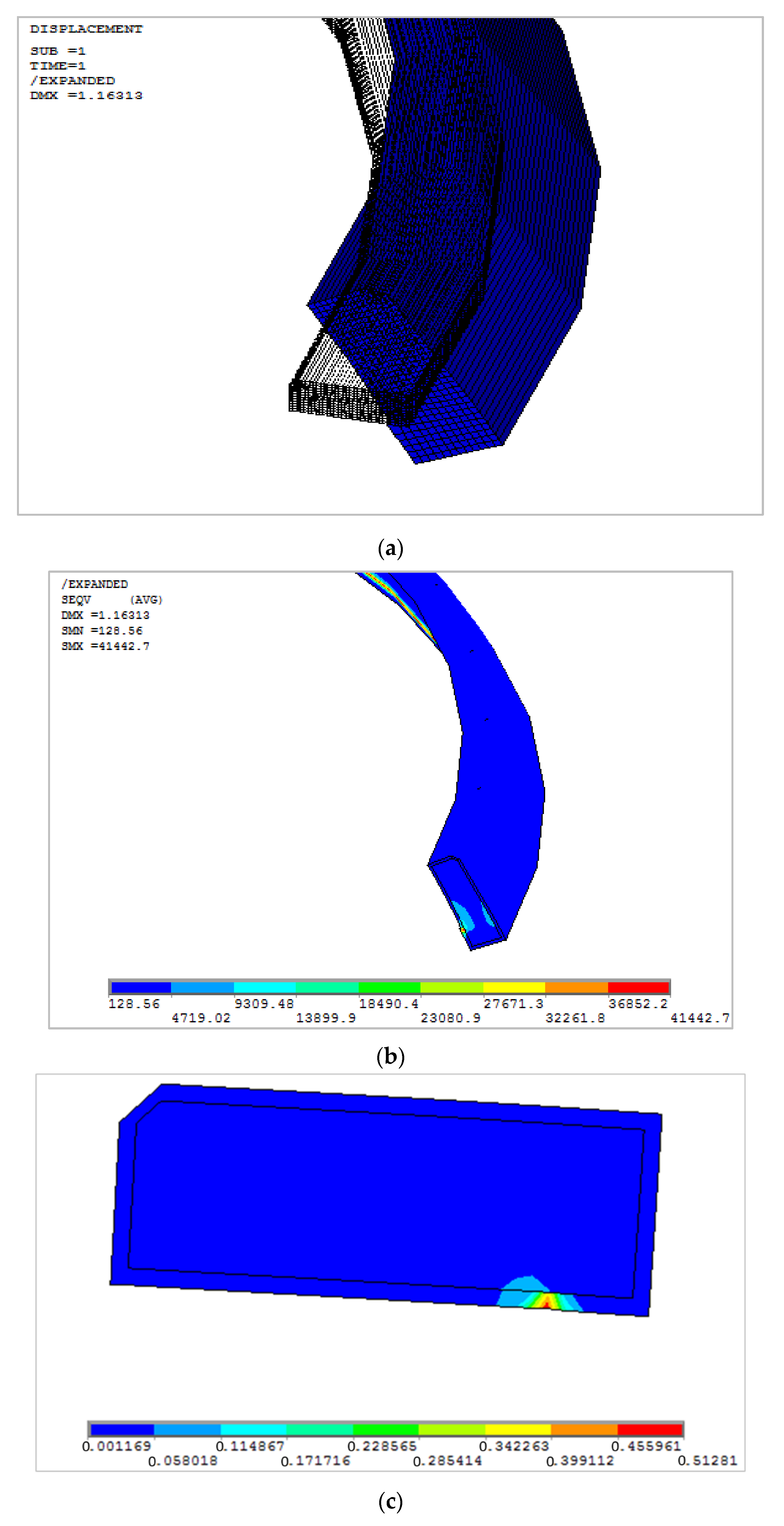
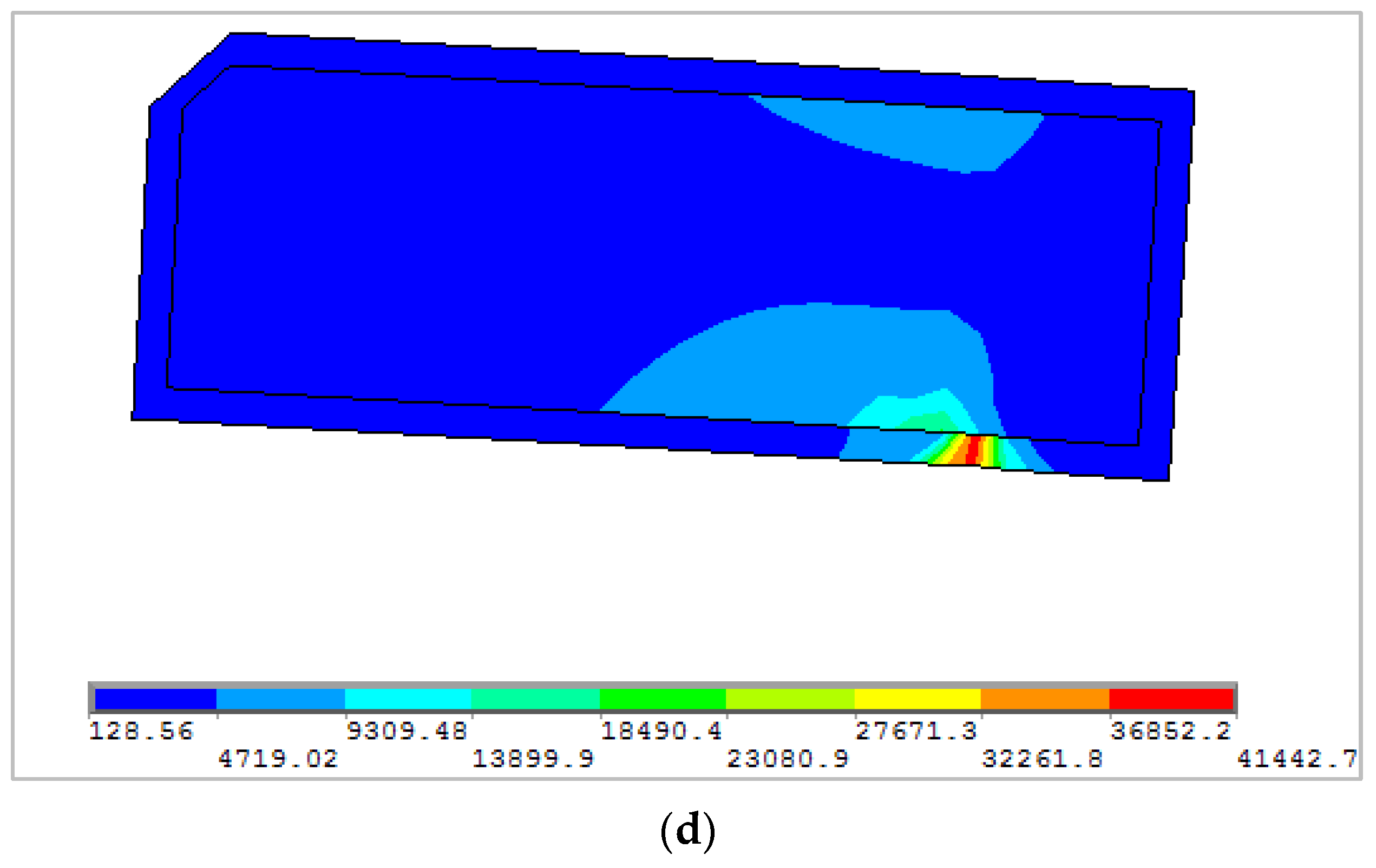
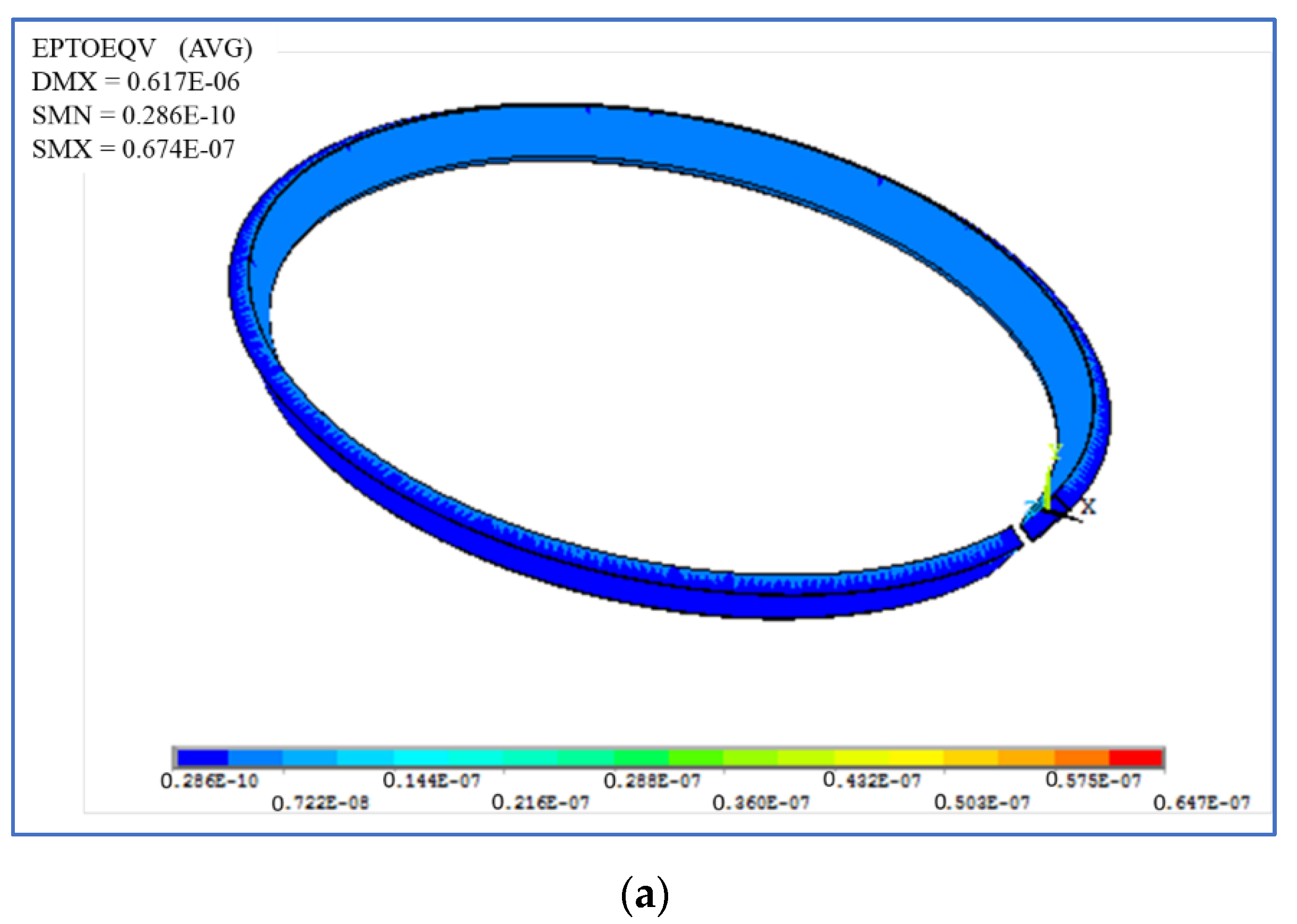
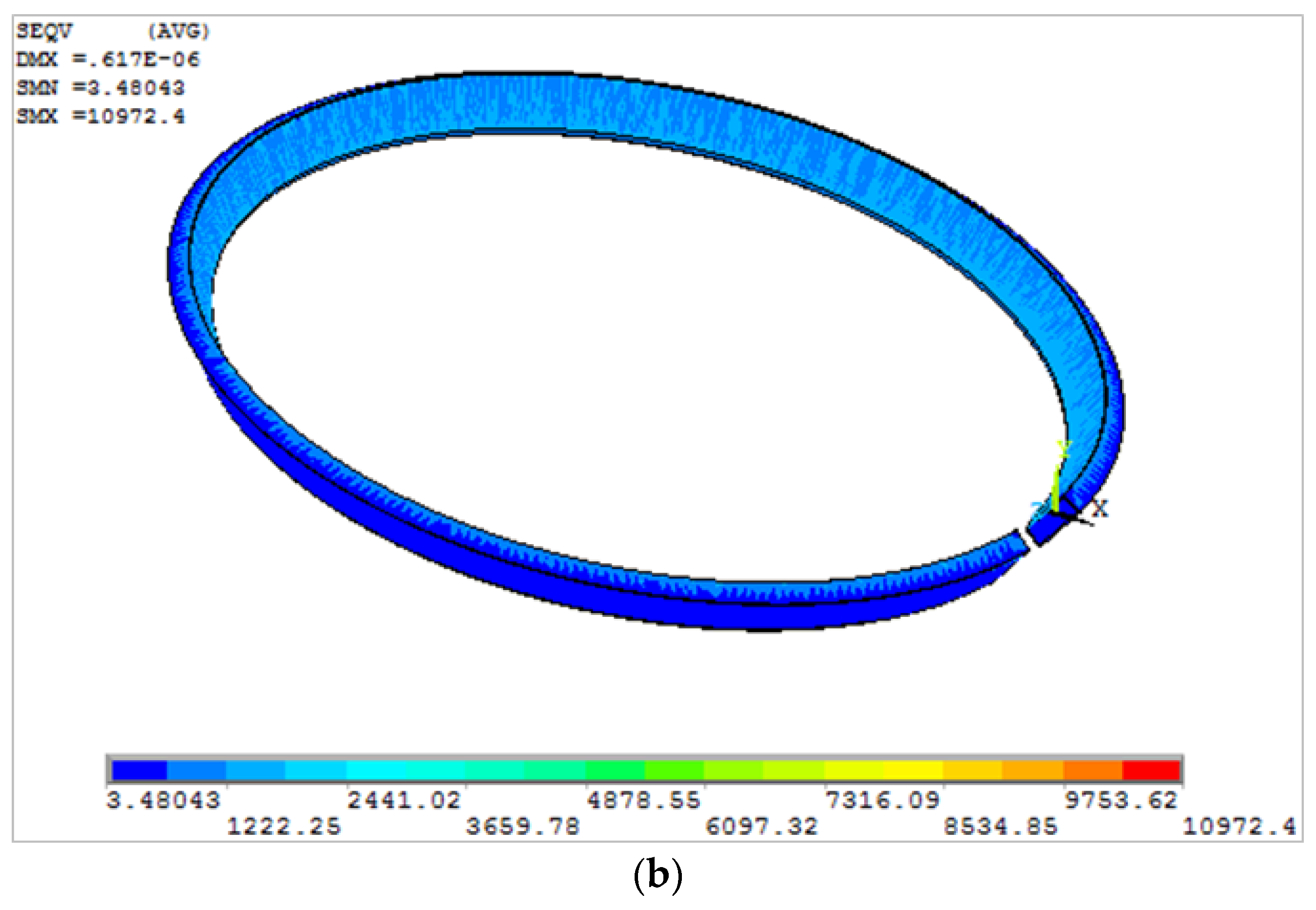
| Ring Elastodynamic Parameter | Value |
|---|---|
| Elastic modulus | 205 GPa |
| Poisson’s ratio | 0.27 |
| Ring density | 7.850 g/mm3 |
| Ring radial width | 3.2 mm |
| Ring axial width | 1.2 mm |
| Nominal radius of fitted ring | 44.52 mm |
| Ring second moment area | 2.25 × 10−12 mm4 |
| Ring Roughness Parameter | Value |
|---|---|
| Ra for the liner | 0.26 µm |
| Ra for the ring | 0.408 µm |
| Roughness parameter | 0.074 |
| Measure of asperity gradient | 0.309 |
| Lubrication Parameter | Value |
|---|---|
| Pressure–viscosity coefficient | 2 × 10−8 m2/N |
| Thermal expansion coefficient | 6.5 × 10−4 1/K |
| Lubricant oil density | 833.8 at 40 °C, 783.8 at 100 °C |
| Lubricant kinetic viscosity | 59.99 at 40 °C, 9.59.8 at 100 °C |
| N = 1000 rpm, Rigid Ring | N = 1000 rpm, Elastic Ring | N = 1500 rpm, Rigid Ring | N = 1500 rpm, Elastic Ring | N = 2000 rpm, Rigid Ring | N = 2000 rpm, Elastic Ring | |
|---|---|---|---|---|---|---|
| Suction | 2.7 | 4.1 | 5.7 | 3.4 | 5.3 | 8 |
| Compression | 3.4 | 5 | 6.3 | 5.6 | 5.4 | 7.3 |
| Power | 2.2 | 3.3 | 3.4 | 2.9 | 3.5 | 5 |
| Exhaust | 2.7 | 4.1 | 6.7 | 4.2 | 5.35 | 7.8 |
| N = 1000 rpm, Rigid Ring | N = 1000 rpm, Elastic Ring | N = 1500 rpm, Rigid Ring | N = 1500 rpm, Elastic Ring | N = 2000 rpm, Rigid Ring | N = 2000 rpm, Elastic Ring | |
|---|---|---|---|---|---|---|
| Suction | 38 | 65 | 86 | 120 | 135 | 180 |
| Compression | 42 | 54 | 82.3 | 101 | 143 | 160 |
| Power | 80 | 250 | 340 | 280 | 240 | 330 |
| Exhaust | 42 | 63 | 83 | 105 | 134 | 160 |
| N = 1000 rpm, Rigid Ring | N = 1000 rpm, Elastic Ring | N = 1500 rpm, Rigid Ring | N = 1500 rpm, Elastic Ring | N = 2000 rpm, Rigid Ring | N = 2000 rpm, Elastic Ring | |
|---|---|---|---|---|---|---|
| Suction | 0.051 | 0.06 | 0.116 | 0.095 | 0.13 | 0.16 |
| Compression | 0.046 | 0.058 | 0.11 | 0.085 | 0.131 | 0.145 |
| Power | 0.032 | 0.038 | 0.065 | 0.06 | 0.09 | 0.1 |
| Exhaust | 0.051 | 0.06 | 0.115 | 0.083 | 0.128 | 0.16 |
| Component | Material | E | υ |
|---|---|---|---|
| Ring core | Steel | 205 GPa | 0.3 |
| Coating | Nikasil | 110 GPa | 0.2 |
Publisher’s Note: MDPI stays neutral with regard to jurisdictional claims in published maps and institutional affiliations. |
© 2022 by the authors. Licensee MDPI, Basel, Switzerland. This article is an open access article distributed under the terms and conditions of the Creative Commons Attribution (CC BY) license (https://creativecommons.org/licenses/by/4.0/).
Share and Cite
Biswal, S.; Mishra, P.C. Piston Compression Ring Elastodynamics and Ring–Liner Elastohydrodynamic Lubrication Correlation Analysis. Lubricants 2022, 10, 356. https://doi.org/10.3390/lubricants10120356
Biswal S, Mishra PC. Piston Compression Ring Elastodynamics and Ring–Liner Elastohydrodynamic Lubrication Correlation Analysis. Lubricants. 2022; 10(12):356. https://doi.org/10.3390/lubricants10120356
Chicago/Turabian StyleBiswal, Swagatika, and Prakash Chandra Mishra. 2022. "Piston Compression Ring Elastodynamics and Ring–Liner Elastohydrodynamic Lubrication Correlation Analysis" Lubricants 10, no. 12: 356. https://doi.org/10.3390/lubricants10120356
APA StyleBiswal, S., & Mishra, P. C. (2022). Piston Compression Ring Elastodynamics and Ring–Liner Elastohydrodynamic Lubrication Correlation Analysis. Lubricants, 10(12), 356. https://doi.org/10.3390/lubricants10120356






